
African American girl playing pan pipes
Browse 440+ panpipe player stock photos and images available, or start a new search to explore more stock photos and images.

African American girl playing pan pipes

La Paz, Bolívia - August 16, 2015: A group of women play Panpipes in a street in La Paz.

Yardley, Bucks County, Pennsylvania, USA - September 12, 2021 - Eco del Sur performing traditional South American music at Music On Main, a weekly musical event, which takes place in the town of Yardley during the summer season.
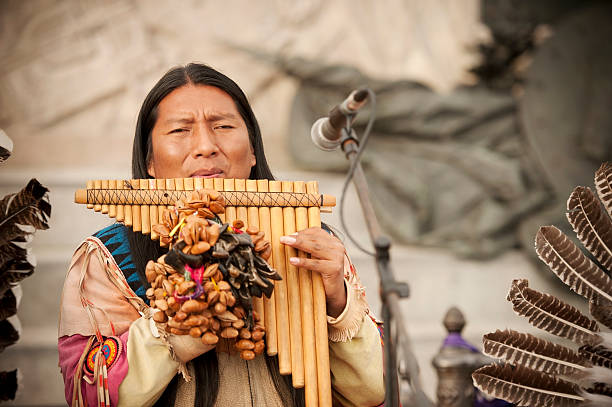
Venice, Italy - March 3, 2014: Peruvian musician with long hair playing on a traditional musical instrument named flute de pan on Piazza San Marco at sea side. The musician wearing wearing national costumes with plume. Venice, Italy.

Unleashing creativity in solitude: This eccentric, grey-haired musician with autism embraces his passion for music, finding solace and inspiration in the tranquil surroundings of his backyard
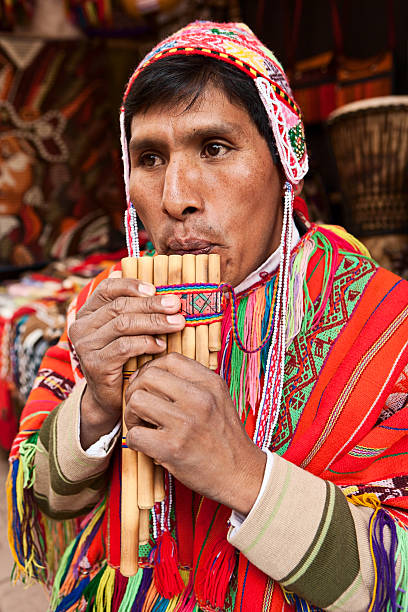
Pisac is a Peruvian village in the Sacred Valley on the Urubamba River. The village is well-known for its market every Sunday, Tuesday, and Thursday, an event which attracts heavy tourist traffic from nearby Cusco. One of its more notable features is a large pisonay tree which dominates the central plaza. The sanctuary of Huanca, home to a sacred shrine, is also near the village. Pilgrims travel to the shrine every September. The area is perhaps best known for its Incan ruins, known as Inca Pisac, which lie atop a hill at the entrance to the valley. The ruins are separated along the ridge into four groups: Pisaqa, Intihuatana, Q'allaqasa, and Kinchiracay. Intihuatana includes a number of bathes and temples. The Temple of the Sun, a volcanic outcrop carved into a "hitching post" for the Sun (or Inti), is the focus, and the angles of its base suggest that it served some astronomical function. Q'allaqasa, which is built onto a natural spur and overlooks the valley, is known as the citadel.http://bem.2be.pl/IS/peru_380.jpg

Unleashing creativity in solitude: This eccentric, grey-haired musician with autism embraces his passion for music, finding solace and inspiration in the tranquil surroundings of his backyard

Wind Musical Instruments with Trumpet and Flute Vector Set. Acoustic Tube for Playing Music Blowing into Mouthpiece Concept

Manaus, Brazil - December 05, 2015: Young boy with painted face plays on wooden pan flute in traditional costume of blue feather hat and beads
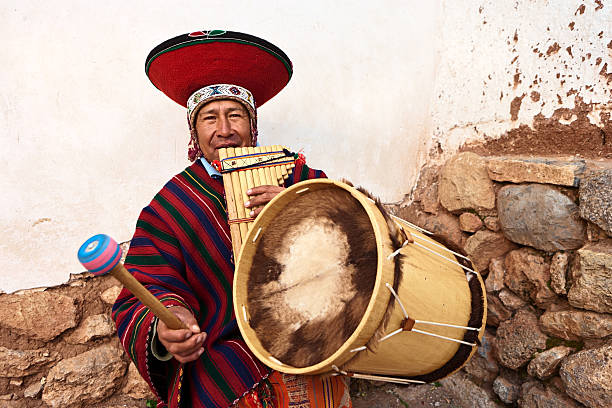
The Sacred Valley of the Incas or Urubamba Valley is a valley in the Andes of Peru, close to the Inca capital of Cusco and below the ancient sacred city of Machu Picchu. The valley is generally understood to include everything between Pisac and Ollantaytambo, parallel to the Urubamba River, or Vilcanota River or Wilcamayu, as this Sacred river is called when passing through the valley. It is fed by numerous rivers which descend through adjoining valleys and gorges, and contains numerous archaeological remains and villages. The valley was appreciated by the Incas due to its special geographical and climatic qualities. It was one of the empire's main points for the extraction of natural wealth, and the best place for maize production in Peruhttp://bem.2be.pl/IS/peru_380.jpg

Vector line icon set of musicians playing variable musical instruments isolated on transparent background

Vintage illustration, Art Nouveau, Faun playing pan pipes to a frog, Classical mythology 19th Century

Pisac is a Peruvian village in the Sacred Valley on the Urubamba River. The village is well-known for its market every Sunday, Tuesday, and Thursday, an event which attracts heavy tourist traffic from nearby Cusco. One of its more notable features is a large pisonay tree which dominates the central plaza. The sanctuary of Huanca, home to a sacred shrine, is also near the village. Pilgrims travel to the shrine every September. The area is perhaps best known for its Incan ruins, known as Inca Pisac, which lie atop a hill at the entrance to the valley. The ruins are separated along the ridge into four groups: Pisaqa, Intihuatana, Q'allaqasa, and Kinchiracay. Intihuatana includes a number of bathes and temples. The Temple of the Sun, a volcanic outcrop carved into a "hitching post" for the Sun (or Inti), is the focus, and the angles of its base suggest that it served some astronomical function. Q'allaqasa, which is built onto a natural spur and overlooks the valley, is known as the citadel.http://bem.2be.pl/IS/peru_380.jpg

Wooden Panpipe and Flute as Romania Traditional Symbol and Object Vector Set. Famous Slavic Country Musical Instrument Concept

Vector line icon set of musicians playing variable musical instruments isolated on transparent background

Venice, Italy - March 3, 2014: Peruvian musician with long hair playing on a traditional musical instrument named flute de pan on Piazza San Marco at sea side. The musician wearing wearing national costumes with plume. Venice, Italy.

Pisac is a Peruvian village in the Sacred Valley on the Urubamba River. The village is well-known for its market every Sunday, Tuesday, and Thursday, an event which attracts heavy tourist traffic from nearby Cusco. One of its more notable features is a large pisonay tree which dominates the central plaza. The sanctuary of Huanca, home to a sacred shrine, is also near the village. Pilgrims travel to the shrine every September. The area is perhaps best known for its Incan ruins, known as Inca Pisac, which lie atop a hill at the entrance to the valley. The ruins are separated along the ridge into four groups: Pisaqa, Intihuatana, Q'allaqasa, and Kinchiracay. Intihuatana includes a number of bathes and temples. The Temple of the Sun, a volcanic outcrop carved into a "hitching post" for the Sun (or Inti), is the focus, and the angles of its base suggest that it served some astronomical function. Q'allaqasa, which is built onto a natural spur and overlooks the valley, is known as the citadel.http://bem.2be.pl/IS/peru_380.jpg

Panpipe line and glyph icon, musical and instrument, flute sign, vector graphics, a linear pattern on a white background, eps 10.

Top view of tambourine and child hands holding pipe on white background

Set of Musical Instruments. Collection in Hand Drawn Style for Surface Design Fliers Prints Cards Banners. Vector Illustration

Pisac is a Peruvian village in the Sacred Valley on the Urubamba River. The village is well-known for its market every Sunday, Tuesday, and Thursday, an event which attracts heavy tourist traffic from nearby Cusco. One of its more notable features is a large pisonay tree which dominates the central plaza. The sanctuary of Huanca, home to a sacred shrine, is also near the village. Pilgrims travel to the shrine every September. The area is perhaps best known for its Incan ruins, known as Inca Pisac, which lie atop a hill at the entrance to the valley. The ruins are separated along the ridge into four groups: Pisaqa, Intihuatana, Q'allaqasa, and Kinchiracay. Intihuatana includes a number of bathes and temples. The Temple of the Sun, a volcanic outcrop carved into a "hitching post" for the Sun (or Inti), is the focus, and the angles of its base suggest that it served some astronomical function. Q'allaqasa, which is built onto a natural spur and overlooks the valley, is known as the citadel.http://bem.2be.pl/IS/peru_380.jpg

Piazza Andrea Mantegna, Mantova, Italy - October 30, 2016: Native American musicians playing their traditional music with particular handmade instruments on Mantegna Square in Mantova
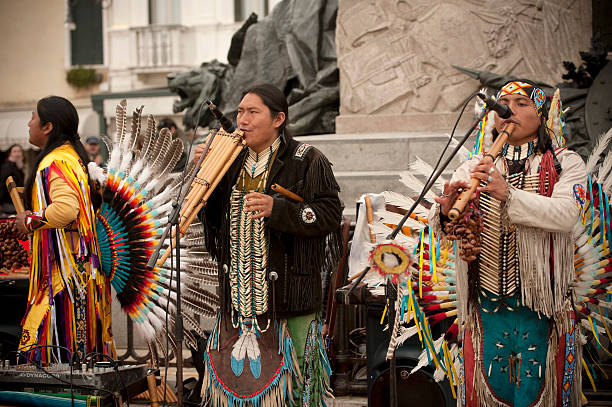
Venice, Italy - February 28, 2014: Peruvian music band playing on a traditional musical instrument named flute de pan on Piazza San Marco at sea side. The musicians wearing wearing national costumes with plume. Venice, Italy.

Animals playing intruments, vector illustration

Vector set of kids musical instruments drawn in cartoon style. Isolated on white background cute children's musical toys - synthesizer, saxophone, drum, trumpet, flute, maracas, harmonica

music color vector icons on paper stickers

Bucharest, Romania - June 17 2023: A music band of street artists playing on Victory Street (Calea Victoriei) in the center of Bucharest.

Ballycastle, UK - August 26th, 2024: man with long hair wearing colourful patterned top holding pan pipes, traditional South American flute music, street performer.

Authentic south american panflutes in local market in Peru.

Pisac is a Peruvian village in the Sacred Valley on the Urubamba River. The village is well-known for its market every Sunday, Tuesday, and Thursday, an event which attracts heavy tourist traffic from nearby Cusco. One of its more notable features is a large pisonay tree which dominates the central plaza. The sanctuary of Huanca, home to a sacred shrine, is also near the village. Pilgrims travel to the shrine every September. The area is perhaps best known for its Incan ruins, known as Inca Pisac, which lie atop a hill at the entrance to the valley. The ruins are separated along the ridge into four groups: Pisaqa, Intihuatana, Q'allaqasa, and Kinchiracay. Intihuatana includes a number of bathes and temples. The Temple of the Sun, a volcanic outcrop carved into a "hitching post" for the Sun (or Inti), is the focus, and the angles of its base suggest that it served some astronomical function. Q'allaqasa, which is built onto a natural spur and overlooks the valley, is known as the citadel.http://bem.2be.pl/IS/peru_380.jpg

Unleashing creativity in solitude: This eccentric, grey-haired musician with autism embraces his passion for music, finding solace and inspiration in the tranquil surroundings of his backyard
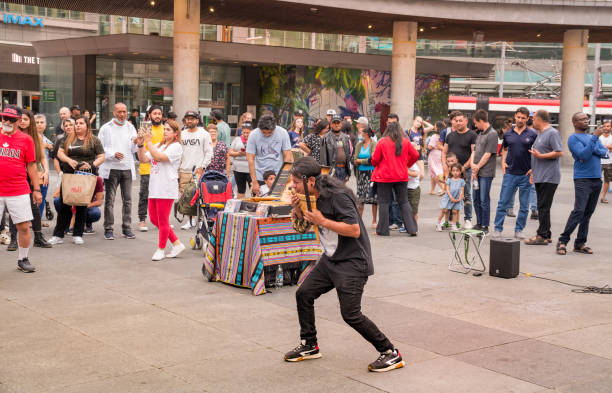
Toronto, Canada - 07 01 2022: Street musician playing pan flute in a circle of spectators on Yonge-Dundas square in downtown Toronto in warm summer evening.

Happy Musical Girl Character Standing and Playing Panpipe Vector Illustration. Young Kid with Musical Instrument Performing Concert
© 2025 iStockphoto LP. The iStock design is a trademark of iStockphoto LP. Browse millions of high-quality stock photos, illustrations, and videos.
Do Not Sell or Share